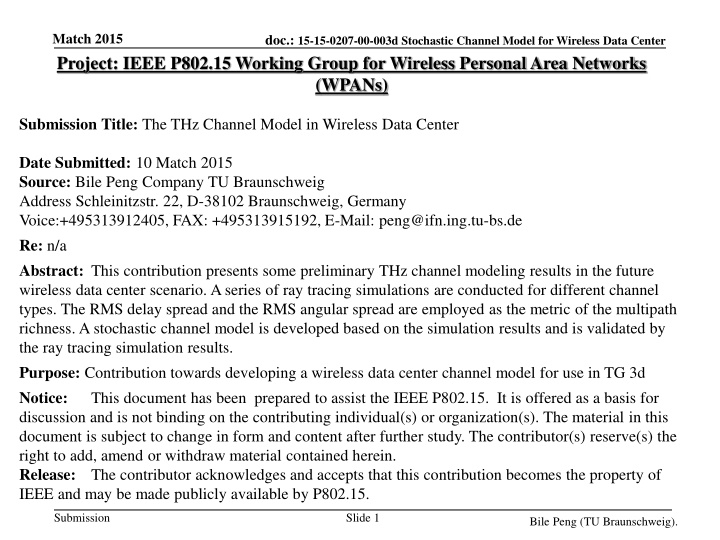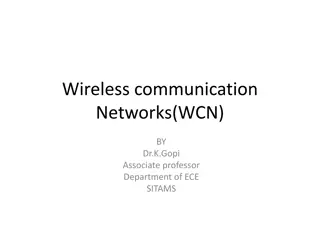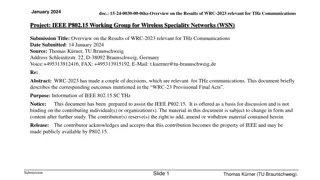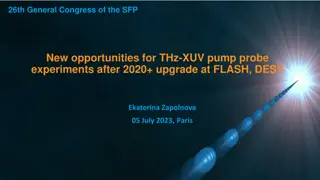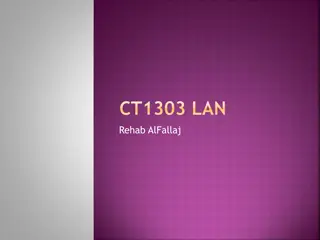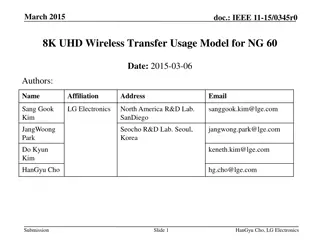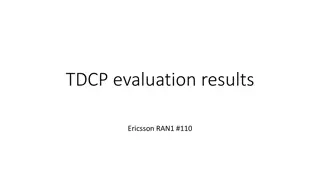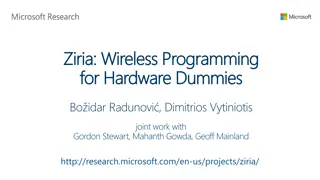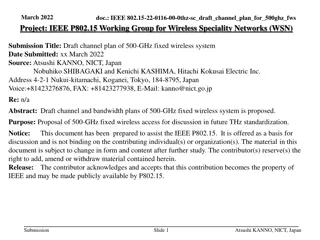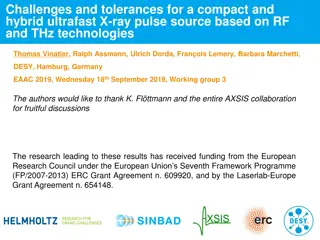The THz Channel Model in Wireless Data Center
This contribution presents preliminary THz channel modeling results for future wireless data center scenarios. Ray tracing simulations are conducted for various channel types, utilizing RMS delay spread and RMS angular spread to measure multipath richness. A stochastic channel model is developed and validated based on simulation results. The study aims to develop a wireless data center channel model for use in TG 3d.
Download Presentation

Please find below an Image/Link to download the presentation.
The content on the website is provided AS IS for your information and personal use only. It may not be sold, licensed, or shared on other websites without obtaining consent from the author.If you encounter any issues during the download, it is possible that the publisher has removed the file from their server.
You are allowed to download the files provided on this website for personal or commercial use, subject to the condition that they are used lawfully. All files are the property of their respective owners.
The content on the website is provided AS IS for your information and personal use only. It may not be sold, licensed, or shared on other websites without obtaining consent from the author.
E N D
Presentation Transcript
Match 2015 Project: IEEE P802.15 Working Group for Wireless Personal Area Networks (WPANs) doc.: 15-15-0207-00-003d Stochastic Channel Model for Wireless Data Center Submission Title: The THz Channel Model in Wireless Data Center Date Submitted: 10 Match 2015 Source: Bile Peng Company TU Braunschweig Address Schleinitzstr. 22, D-38102 Braunschweig, Germany Voice:+495313912405, FAX: +495313915192, E-Mail: peng@ifn.ing.tu-bs.de Re: n/a Abstract: This contribution presents some preliminary THz channel modeling results in the future wireless data center scenario. A series of ray tracing simulations are conducted for different channel types. The RMS delay spread and the RMS angular spread are employed as the metric of the multipath richness. A stochastic channel model is developed based on the simulation results and is validated by the ray tracing simulation results. Purpose: Contribution towards developing a wireless data center channel model for use in TG 3d Notice: This document has been prepared to assist the IEEE P802.15. It is offered as a basis for discussion and is not binding on the contributing individual(s) or organization(s). The material in this document is subject to change in form and content after further study. The contributor(s) reserve(s) the right to add, amend or withdraw material contained herein. Release: The contributor acknowledges and accepts that this contribution becomes the property of IEEE and may be made publicly available by P802.15. Submission Slide 1 Bile Peng (TU Braunschweig).
Match 2015 doc.: 15-15-0207-00-003d Stochastic Channel Model for Wireless Data Center A Stochastic THz Channel Model in Wireless Data Centers Bile Peng, Thomas K rner TU Braunschweig Submission Slide 2 Bile Peng (TU Braunschweig)
Match 2015 doc.: 15-15-0207-00-003d Stochastic Channel Model for Wireless Data Center Contents Motivation Ray Tracing Simulation Results Stochastic Channel Model Conclusion Submission Slide 3 Bile Peng (TU Braunschweig)
Match 2015 doc.: 15-15-0207-00-003d Stochastic Channel Model for Wireless Data Center Motivation The data center link is responsible for the cooperation between computers and must achieve very high data rates. The data center link is prevailingly wired. However, the wireless link has some significant advantages [1]: More flexibility Less maintenance cost More space for cooling The high data rates of Terahertz (THz) communications makes it a competitive candidate. This report is a preliminary PHY layer feasibility study of the application of the THz communication in the data center wireless backhaul. Submission Slide 4 Bile Peng (TU Braunschweig)
Match 2015 doc.: 15-15-0207-00-003d Stochastic Channel Model for Wireless Data Center Radio Wave Propagation Paths [2,3] Ceiling Type 1: LoS Type 2: NLoS Type 3: Adjacent casings Reflector Submission Slide 5 Bile Peng (TU Braunschweig)
Match 2015 doc.: 15-15-0207-00-003d Stochastic Channel Model for Wireless Data Center Selection of Propagation Path Type (1/2) If transmitter and receiver are on the same or adjacent casings, they can be positioned lower than the casing roof to reduce the interference. Reflector Submission Slide 6 Bile Peng (TU Braunschweig)
Match 2015 doc.: 15-15-0207-00-003d Stochastic Channel Model for Wireless Data Center Selection of Propagation Path Type (2/2) If transmitter and receiver are close enough, we use the NLoS path with reflection on the ceiling. The short distance compensates for the reflection loss. The AoD/AoA elevations are far from the horizonal direction, which reduces the interference on the LoS paths. Ceiling 1 2 Criterion: the elevation ( ) is at least 2 times Half-Power-Beamwith away from the horizontal direction. Otherwise we select the LoS path. Submission Slide 7 Bile Peng (TU Braunschweig)
Match 2015 doc.: 15-15-0207-00-003d Stochastic Channel Model for Wireless Data Center Simulation Environment Transmitter Receiver Casing Typical data center (source: http://www.enterprisetech.com/wp- content/uploads/2014/11/SIO_DataCenter_Rows1.jpg) Wall Propagation path Ray tracing simulation Submission Slide 8 Bile Peng (TU Braunschweig)
Match 2015 doc.: 15-15-0207-00-003d Stochastic Channel Model for Wireless Data Center Contents Motivation Ray Tracing Simulation Results Stochastic Channel Model Conclusion Submission Slide 9 Bile Peng (TU Braunschweig)
Match 2015 doc.: 15-15-0207-00-003d Stochastic Channel Model for Wireless Data Center Statistical Characteristics With Type 1/2 Type1/2: LoS/nLoS channels between 2 nonadjacent casings Multipath richness metric: RMS delay spread with omniantenna Parity pattern due to reflections on the casing roof RMS delay spread RMS delay spread 10 10 Tx 2 2 8 8 4 4 6 6 server in y server in y Tx 6 6 4 4 8 8 2 2 10 10 0 0 5 10 15 5 10 15 ns ns server in x server in x Submission Slide 10 Bile Peng (TU Braunschweig)
Match 2015 doc.: 15-15-0207-00-003d Stochastic Channel Model for Wireless Data Center Impact of Directive Antenna RMS delay spread RMS delay spread 10 10 2 2 8 8 4 4 6 server in y 6 server in y 6 6 4 4 8 8 2 2 10 10 0 0 5 10 15 5 10 15 ns ns server in x server in x Omniantenna Directive phased array Antenna: 4x4 phased array The directive antenna reduces the RMS delay spread significantly. Submission Slide 11 Bile Peng (TU Braunschweig)
Match 2015 doc.: 15-15-0207-00-003d Stochastic Channel Model for Wireless Data Center Statistical Characteristics With Type 1/2 Type1/2: LoS/nLoS channels between 2 nonadjacent casings Multipath richness metric: RMS angular spread with omniantenna Parity pattern due to reflections on the casing roof RMS angular spread RMS angular spread 60 60 Tx 50 2 50 2 40 40 4 4 server in y server in y Tx 30 30 6 6 20 20 8 8 10 10 10 10 0 0 5 10 15 5 10 15 server in x server in x Submission Slide 12 Bile Peng (TU Braunschweig)
Match 2015 doc.: 15-15-0207-00-003d Stochastic Channel Model for Wireless Data Center Impact of Directive Antenna RMS angular spread RMS AoD elevation spread 60 60 50 50 2 2 40 40 4 4 server in y server in y 30 30 6 6 20 20 8 8 10 10 10 10 0 0 5 10 15 5 10 15 server in x server in x Omniantenna Directive phased array Antenna: 4x4 phased array The directive antenna reduces the RMS angular spread significantly as well. Submission Slide 13 Bile Peng (TU Braunschweig)
Match 2015 doc.: 15-15-0207-00-003d Stochastic Channel Model for Wireless Data Center Statistical Characteristics With Type 3 Type 3: channels between 2 adjacent casings Randomly generated adjacent Tx and Rx The RMS delay spread is lower than the in type 1/2 because of the limited propagation space. 0.7 1 0.6 0.8 0.5 0.6 Frequency Frequency 0.4 0.3 0.4 0.2 0.2 0.1 0 0 0 1 2 3 4 5 6 0 0.05 0.1 0.15 0.2 RMS delay spread (ns) Omniantenna RMS delay spread (ns) Directive phased array Submission Slide 14 Bile Peng (TU Braunschweig)
Match 2015 doc.: 15-15-0207-00-003d Stochastic Channel Model for Wireless Data Center Statistical Characteristics With Type 3 Type 3: channels between 2 adjacent casings Randomly generated adjacent Tx and Rx The RMS angular spread is lower than the in type 1/2 because of the limited propagation space. 0.7 0.6 0.5 Frequency 0.4 0.3 0.2 0.1 0 0 10 20 30 40 50 RMS angle spread Submission Slide 15 Bile Peng (TU Braunschweig)
Match 2015 doc.: 15-15-0207-00-003d Stochastic Channel Model for Wireless Data Center Contents Motivation Ray Tracing Simulation Results Stochastic Channel Model Conclusion Submission Slide 16 Bile Peng (TU Braunschweig)
Match 2015 doc.: 15-15-0207-00-003d Stochastic Channel Model for Wireless Data Center Stochastic Channel Model 1. 2. 3. 4. 5. 6. 7. Determine number of paths. Determine delay for each path. Determine pathloss according to delay. Determine angles. Generate uniformly distributed phases. Generate frequency dispersions (Friis law). Generate polarisations. Submission Slide 17 Bile Peng (TU Braunschweig)
Match 2015 doc.: 15-15-0207-00-003d Stochastic Channel Model for Wireless Data Center Numbers of Paths Type 1/2, Tx 1 (in corner) LoS 1 100% Number of paths Probability Reflections 17 27 18 35 19 22 20 15 21 1 Number of paths Probability (%) Submission Slide 18 Bile Peng (TU Braunschweig)
Match 2015 doc.: 15-15-0207-00-003d Stochastic Channel Model for Wireless Data Center Numbers of Paths Type 1/2, Tx 2 (in center) LoS 1 100% Number of paths Probability Reflections 16 32 17 29 18 12 19 16 20 8 21 3 Number of paths Probability (%) Submission Slide 19 Bile Peng (TU Braunschweig)
Match 2015 doc.: 15-15-0207-00-003d Stochastic Channel Model for Wireless Data Center Numbers of Paths Type 3 (Adjacent casings) LoS 1 100% Number of paths Probability Reflections 3 4 5 6 7 8 9 10 11 Number of paths 22 13 8 15 8 17 8 6 3 Probability (%) Submission Slide 20 Bile Peng (TU Braunschweig)
Match 2015 doc.: 15-15-0207-00-003d Stochastic Channel Model for Wireless Data Center Delay Distribution: type 1/2, Tx 1 LOS Reflection 0.2 0.4 0.35 0.15 0.3 0.25 Probability Probability 0.1 0.2 0.15 0.05 0.1 0.05 0 0 0 20 Delay (ns) 40 60 0 50 100 Relative delay (ns) Path LOS NLOS Distribution Normal distribution Negative EXP Parameters =2.26e-8, =8.76e-9 =4.26e7 Submission Slide 21 Bile Peng (TU Braunschweig)
Match 2015 doc.: 15-15-0207-00-003d Stochastic Channel Model for Wireless Data Center Delay Distribution: type 1/2, Tx 2 LOS Reflection 0.2 0.25 0.2 0.15 0.15 Probability Probability 0.1 0.1 0.05 0.05 0 0 0 10 Delay (ns) 20 30 0 50 100 Relative delay (ns) Path LOS NLOS Distribution Normal distribution Normal distribution Parameters =1.20e-8, =4.56e-9 =2.98e-8, =1.79e-8 Submission Slide 22 Bile Peng (TU Braunschweig)
Match 2015 doc.: 15-15-0207-00-003d Stochastic Channel Model for Wireless Data Center Delay Distribution: type 3 LOS Reflection 0.35 0.35 0.3 0.3 0.25 0.25 Probability Probability 0.2 0.2 0.15 0.15 0.1 0.1 0.05 0.05 0 0 0 2 Delay (ns) 4 6 0 50 100 Relative delay (ns) Path LOS NLOS Distribution Normal distribution Negative EXP Parameters =1.80e-8, =8.60e-9 =4.92e7 Submission Slide 23 Bile Peng (TU Braunschweig)
Match 2015 doc.: 15-15-0207-00-003d Stochastic Channel Model for Wireless Data Center Delay-Pathloss Correlation: type 1/2, Tx 1 Path LOS NLOS Deterministic part p=-20log10(d)-71.52 pr=-0.294dr-17.44 Random part (Norm.) =0 =4 Submission Slide 24 Bile Peng (TU Braunschweig)
Match 2015 doc.: 15-15-0207-00-003d Stochastic Channel Model for Wireless Data Center Delay-Pathloss Correlation: type 1/2, Tx 2 Path LOS NLOS Deterministic part p=-20log10(d)-71.52 pr=-0.385dr-17.95 Random part (Norm.) =0 =4 Submission Slide 25 Bile Peng (TU Braunschweig)
Match 2015 doc.: 15-15-0207-00-003d Stochastic Channel Model for Wireless Data Center Delay-Pathloss Correlation: type 3 Path LOS NLOS Deterministic part p=-20log10(d)-71.52 pr=-0.429dr-30.3 Random part (Norm.) =0 =6 Submission Slide 26 Bile Peng (TU Braunschweig)
Match 2015 doc.: 15-15-0207-00-003d Stochastic Channel Model for Wireless Data Center Pathloss-Angle Correlation Since we want to reduce the multipath effect by highly directive antenna, the propagation paths with low pathloss and similar Angle of Arroval (AoA) to LOS path has a negative impact on the system design. There is no appropriate distribution to describe the relation, therefore we use the correlation matrix. 0.45 180 0.4 160 0.35 140 Angular difference ( ) 0.3 120 0.25 100 80 0.2 60 0.15 40 0.1 20 0.05 0 -70 -60 -50 -40 -30 -20 -10 0 Relative Pathloss (dB) Submission Slide 27 Bile Peng (TU Braunschweig)
Match 2015 doc.: 15-15-0207-00-003d Stochastic Channel Model for Wireless Data Center Stochastic Channel Example -90 180 LoS path -100 160 -110 140 Angular difference ( ) -120 120 Path gain (dB) -130 100 -140 80 LoS path -150 60 -160 40 -170 20 -180 0 0 0.5 1 1.5 2 -160 -150 -140 -130 -120 -110 -100 Time (s) Pathloss (dB) -8 x 10 Channel impulse response Pathloss-angle distribution Submission Slide 28 Bile Peng (TU Braunschweig)
Match 2015 doc.: 15-15-0207-00-003d Stochastic Channel Model for Wireless Data Center Validation via RMS Delay Spread 0.35 0.5 0.3 0.4 0.25 0.3 Frequency Frequency 0.2 0.15 0.2 0.1 0.1 0.05 0 0 0 2 4 6 8 10 12 0 2 4 6 8 10 12 RMS delay spread (ns) RMS delay spread (ns) Ray Tracing simulation Stochastic channel model Submission Slide 29 Bile Peng (TU Braunschweig)
Match 2015 doc.: 15-15-0207-00-003d Stochastic Channel Model for Wireless Data Center Validation via RMS Angular Spread 0.45 0.4 0.4 0.35 0.35 0.3 0.3 0.25 Frequency Frequency 0.25 0.2 0.2 0.15 0.15 0.1 0.1 0.05 0.05 0 0 0 10 20 30 40 50 60 70 80 0 10 20 30 40 50 60 70 80 RMS angle spread (ns) RMS angle spread (ns) Ray Tracing simulation Stochastic channel model The similar distribution of RMS delay/angle spreads validate the stochastical model. Submission Slide 30 Bile Peng (TU Braunschweig)
Match 2015 doc.: 15-15-0207-00-003d Stochastic Channel Model for Wireless Data Center Contents Motivation Ray Tracing Simulation Results Stochastic Channel Model Conclusion Submission Slide 31 Bile Peng (TU Braunschweig)
Match 2015 doc.: 15-15-0207-00-003d Stochastic Channel Model for Wireless Data Center Conclusion The THz communication is a competitive solution for the next generation wireless data center. A ray tracing simulation environment is set up to investigate the channel characteristics. The multipath propagation is a major hurdle of the high speed error free data transmission and the RMS delay/angular spread is used as metric of the multipath richness. A stochastic channel model is developed according to the ray tracing simulation results. Submission Slide 32 Bile Peng (TU Braunschweig)
Match 2015 doc.: 15-15-0207-00-003d Stochastic Channel Model for Wireless Data Center List of References 1. T. K rner, Literature review on requirements for wireless data centers doc.: IEEE 802.15-13-0411-00-0thz_Literature Review Zhang W et. al, 3D beamforming for wireless data centers , in Proceedings of the 10th ACM Workshop on Hot Topics in Networks. 2011 K. Ramchadran 60 GHz Data-Center Networking: Wireless Worry less? , 2008 2. 3. Submission Slide 33 Bile Peng (TU Braunschweig)
